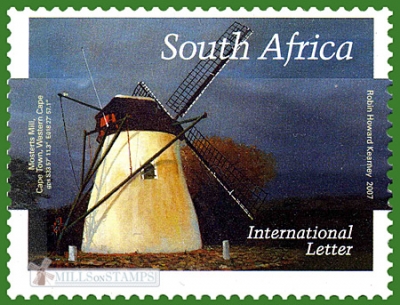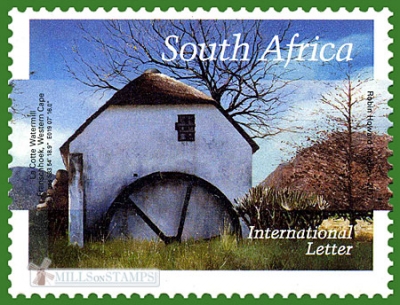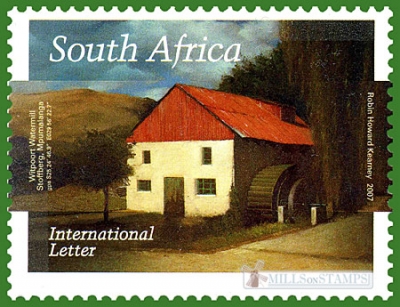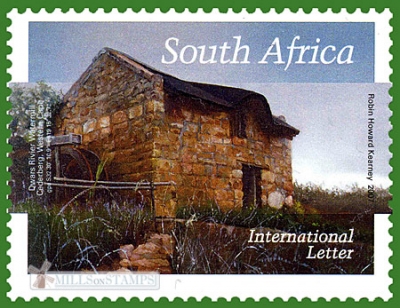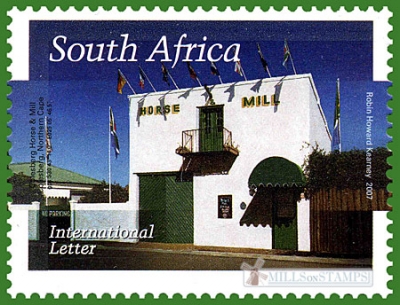-
Mills of South Africa
South Africa 2007.11.09
In issue: Stamp(s): 5
Printing: offset
Issued in: mini sheets of 10 stamps (2 sets)
-
Number by catalogue: Yvert: 1422 Scott: 1375a
Perforation type: 14 ½x14 ¾
Subject:
All stamps in this issue are without face value, with payment of the international letter, for the moment of issue - 4.64 rands.
Mostert's mill, Western CapeAdditional:
This is the best known and only complete windmill in South Africa still surviving. It was built on the Welgelegen farm granted to Cornelis Stevensz Botma in 1676. The farm changed hands several times before 1756 when Jacob van Reenen became the owner. The windmill is thought to have been built by Dirk Gysbert van Reenen, Jacob's son, in 1796. The next owner was Dirk's son-in-law, Sybrand Mostert, after whom the mill was named. The mill remained in the Mostert family until 1889, when it was sold to a man called Wilks. In 1891 the mill was purchased by Cecil John Rhodes who was then the Prime Minister of the Cape. Although he employed a young architect, called Herbert Baker, to redesign the old farmhouse, the mill itself fell into disrepair.
In 1935 the mill was restored by the famous Dutch millwright, C. Bremer, and on the 1st February 1936 the mill was opened by Dr. Lorenz, Minister Plenipotentiary and Envoy Extraordinary of the Netherlands. The ceremony was also attended by the Prime Minister, General J. В. M. Hertzog.
As can be seen on the stamp, Mostert's Mill has a truncated cone tower with a thatched cap, typical of Cape windmills. The cap is turned by a braced tailpole using a winch at the bottom of the tailpole. Its chain is attached to a couple of the posts which form a circle around the platform surrounding the mill. Adjoining the mill is a circular threshing floor and a small thatched house for the miller.
It has four common sails, each of which is 6 m long with an overall width of 1.75 m, 1.2 m on the trailing side and 0.4 m on the leading side of the whip. The leading edge also has a windboard to direct the wind onto the sail. None of the original sails survived and so the current sails were designed by Bremer when the mill was restored, but there is no evidence of this design of sail on any other of the Cape mills. Also there is a date board below the windshaft which was also added by Bremer in 1935.
Inside the mill cap, where the machinery appears to be less restored than elsewhere, there is a clasp arm brakewheel reinforced by four wooden cants. The brake consists of two semi-circular wooden blocks linked by an iron bar. One end of the brake blocks is anchored, the free end is attached to the brake lever. The brake lever, with its box of heavy stones, is attached to a pole with a chain hanging down to ground level outside the mill.
The brakewheel engages with a trundle wallower on the square wooden upright shaft which passes down through the mill to the stone floor to drive the one pair of French burr stones. The stone furniture is quite conventional with a hopper, shoe and cylindrical tun. Tentering is by a lighter staff and brayer connected by a lighter iron to the bridgetree underneath the floor. The millstones were raised for dressing with a block and tackle together with wedges.
On completion of the restoration in 1936, C. Bremer left a set of written instructions for maintaining the mill, which are now on display in the mill. Mostert's Mill is now one of the Cape's major tourist attractions.Topics: Windmills
-
Number by catalogue: Yvert: 1423 Scott: 1375b
Perforation type: 14 ½x14 ¾
Subject:
Dwars River Watermill, Cederberg, Western Cape
Additional:
This mill is situated in the beautiful Cederberg Mountains on the Cederberg wine estate. A watermill powered by the Dwars River was built on a farm near Clan William which was established in 1893. This small mill is built of stone and has a wooden overshot waterwheel, which is about 4 m in diameter, with a wooden launder. The South African Post Office indicates that the waterwheel has four compass arm spokes mortised into the wheelshaft, but other sources claim that it was built using clasp arm construction.
Inside the mill, however, the pitwheel, which is about 1.3 m in diameter is made using a compass arm construction. The mill consists of only one pair of stones arranged in a typical "Vitruvian" configuration. All the machinery is contained on the one floor on a wooden hursting. The pitwheel drives a lantern pinion mounted on the millstone spindle. The tentering system dispenses with the brayer arm and has an iron adjusting bar known as a lighter screw secured at its lower end to the free end of the bridgetree. Much of the wood used in the mill is local cedar wood.Topics: Watermills
-
Number by catalogue: Yvert: 1424 Scott: 1375с
Perforation type: 14 ½x14 ¾
Subject:
Witpoort Watermill, Stoffberg, Mpumalanga
Additional:
Towards the end of the 19th century this little watermill was built by Willem Jacobus Volschenk on his farm at Witpoort. This mill played a small but vital role in the Anglo-Boer War because it maintained a supply to Boers for the duration of the war. British forces ordered the mill to be dynamited but, fortunately, only the coarse grinder was destroyed. After a drought in 1963 the waterpowered mill was converted to use tractor power which significantly reduced the time taken for milling. Since then, in 1986, the mill was further upgraded to use electric power which speeded the process up even more.
Today, the attractive red-roofed mill and its metal overshot waterwheel form a fascinating part of what is now a privately owned sporting estate and nature reserve.Topics: Watermills
-
Number by catalogue: Yvert: 1423 Scott: 1375b
Perforation type: 14 ½x14 ¾
Subject:
La Cotte Watermill, Franschhoek, Western Cape
Additional:
The farm of La Cotte in the Franschhoek valley was granted to a Huguenot called Jean Gardiol. The watermill at La Cotte was first mentioned in a deed of 1832 which suggests that the mill was built somewhat earlier in the 19th century. The mill was working in the early 20th century but only the waterwheel, some millstones and the ruined walls survived a disasterous fire.
The mill building is constructed from a combination of stone and clay bricks and has two different gables, one rectilinear with a false chimney and the other hipped, which support a thatched roof. The overshot wooden waterwheel, which has six pairs of spokes, was fed from a wooden launder that was supported by the pillar shown on the stamp at the left hand side of the mill. The miller could operate the hatch in the launder, which varied the amount of water applied to the waterwheel, by means of a cord passing between the bars in the shuttered opening, shown on the stamp under the hipped gable.Topics: Watermills
-
Number by catalogue: Yvert: 1426 Scott: 1375e
Perforation type: 14 ½x14 ¾
Subject:
Colesberg Horse Mill, Colesberg, Northern Cape
Additional:
In the wheat growing region of the Northern Cape nearly every farm had a horse mill, with over a hundred known in the Colesberg area alone. The Karoo farmers, who often had a lack of water or wind, constructed simple horse mills in their barns. The draft animals on the farm were put to work grinding the grain. This mill, which was once a working horse mill on the farm called Sewefontain, has been recreated in an old coach house.
________
This information has been taken from International Molinology Magazine
Topics: Cattle mills


2007-sheet-logo.jpg)
